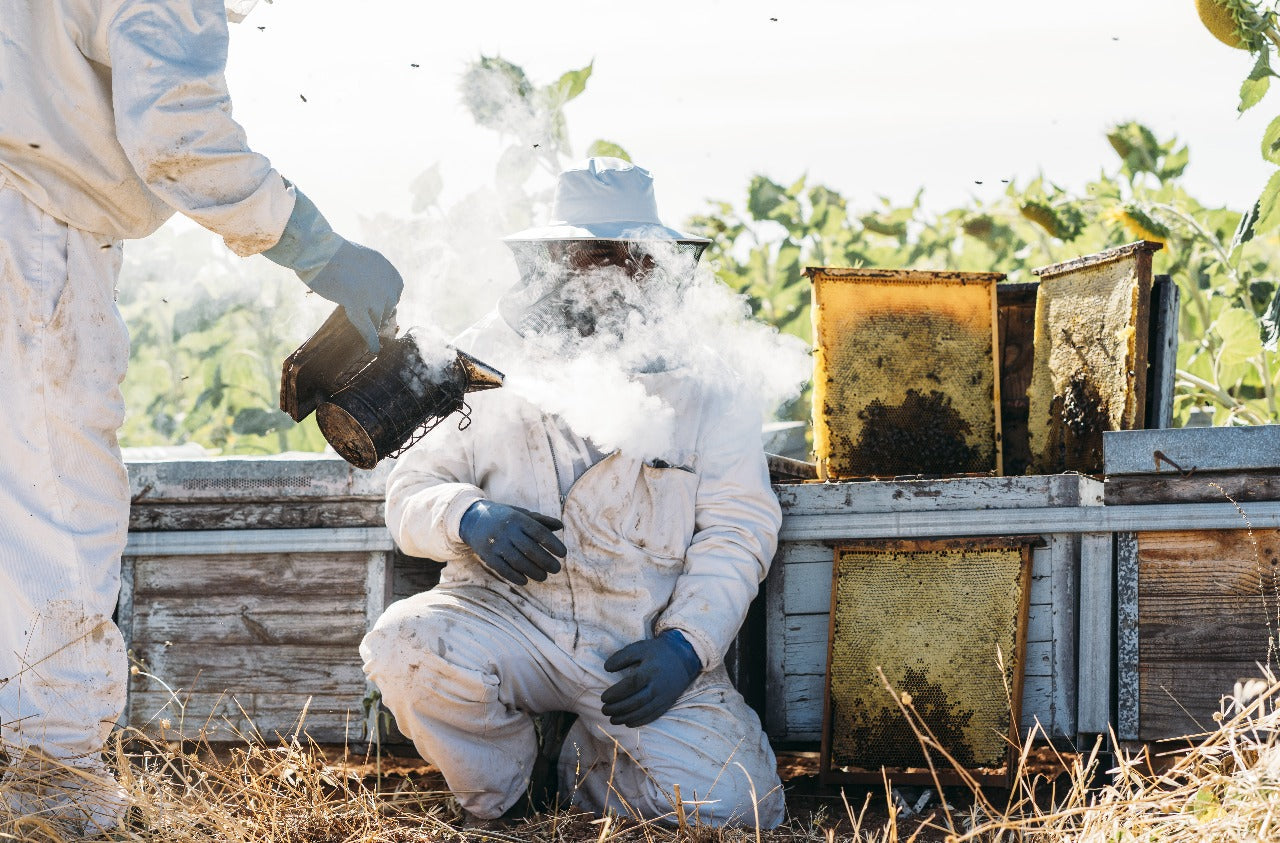Beekeeping smokers are essential to honeybee management and provide beekeepers with a useful tool for preserving colony health and output. During inspections and hive operations, these inventive machines produce smoke deftly applied to honeybee colonies.
While the use of smoke in beekeeping has long been a standard practice, the underlying science of how it affects honeybees is still a subject of interest. To understand how beekeeping smokers affect honeybees, this blog digs into the fascinating world of beekeeping smokers.
Beekeepers can improve their beekeeping techniques and advance their colonies' health by thoroughly understanding how smoke affects these magnificent insects. So, let's embark on a journey to explore the intricate relationship between smoke and honeybees and uncover the secrets behind this essential beekeeping tool.
The Function of Beekeeping Smokers
Specialized equipment called beekeeping smokers is made to produce and manage smoke for beekeeping procedures. Their main objective is to make hive inspections and operations safer and easier for beekeepers by calming honeybees.
A metal canister with bellows or a pump mechanism is the traditional design of a beekeeping smoker. The canister is filled by beekeepers with fuel, often made of dried organic materials like wood chips, burlap, or pine needles. The fuel burns, creating smoke expelled by a nozzle or spout.
The secret to producing smoke efficiently is to keep the burn steady. Beekeepers provide a controlled and consistent smoke output by using a bellows or pump mechanism to give air puffs to the burning fuel. The smoke enters the colony by being directed toward the hive's entrance or through the top cover of the hive.
The smoke performs many crucial tasks. The communication and alarm pheromones that honeybees emit in reaction to perceived dangers are first affected. The bees are kept in check and are prevented from warning the colony of potential danger by this interference. Additionally, the smoke causes the bees to behave in a certain way, which prompts them to eat honey from the hive. Their natural eating behavior also contributes to their momentary calmness.
Understanding the purpose of beekeeping smokers and how they produce and regulate smoke will help beekeepers make the most of this instrument to make the hive inspection and manipulation process calm and manageable. This information enables more efficient beekeeping procedures and improves beekeepers' and honeybee colony health.
Behavioral Response of Honeybees to Smoke
Honeybees perceive smoke as a potential threat to their colony, which causes them to react defensively when they come into contact with it. Bees' natural response is to consume honey and be ready for possible eviction. Contrarily, honeybees find that smoke has a relaxing effect on them.
There are various possibilities, but the calming reaction's precise mechanisms must be better understood. According to one idea, the smoke interferes with the bees' ability to communicate via pheromones. Guard bees emit alarm pheromones when they sense danger, which usually makes other bees defend themselves. Smoke, on the other hand, disrupts the bees' ability to signal, preventing the transmission of alarm hormones and lessening their propensity to attack.
According to a different viewpoint, honeybees feed when smoke is present. They are less aggressive and more focused on acquiring food due to their innate behavior to ingest honey, which diverts their focus and energy. Their general composure during hive inspections is a result of this feeding reaction.
The smoke may also obscure the bees' alarm pheromones, making detecting and amplifying one another's distress messages difficult. This masking effect further minimizes The possibility of hostility, making it safer for the beekeeper to work inside the hive.
Honeybees' behavioral response to smoke consists of communication disruption, feeding behavior induction, and maybe concealing alarm pheromones. Together, these effects help to calm the atmosphere during beekeeping procedures, allowing beekeepers to handle their honeybee colonies more skillfully and safely.
Smoke and Honeybee Communication
Smoke significantly affects how honeybees communicate, particularly by interfering with the alarm pheromones. Worker bees emit alarm pheromones as chemical signals to warn the colony of potential dangers.
These pheromones facilitate quick communication and can make other bees defend themselves. However, when a beekeeping smoker is used, the smoke particles prevent these alarm pheromones from being detected and disseminated.
Honeybees' olfactory sensors are hampered by smoke, making it challenging to recognize and react to alarm pheromones. This disturbance effectively hampers the bees' capacity to alert the colony to danger. As a result, the aggressive reaction that warning pheromones would ordinarily elicit is reduced or even repressed.
Additionally, smoke obstructs worker bees' ability to communicate. Worker bees use pheromones, touch, and dance motions to communicate important details regarding the hive's location, food supplies, and other aspects of colony life. The smoke particles might obstruct pheromone communication, making it harder for the bees to coordinate their operations efficiently.
Smoke reduces tension and hostility in the hive by interfering with honeybee communication. This makes it possible for beekeepers to collect honey, handle hives, or conduct inspections with little disruption to the bee population. The smoker's general soothing impact on honeybees is aided by the communication disruption, allowing for safe and effective beekeeping procedures.
Physical Effects of Smoke on Honeybees
How smoke affects honeybees physically is essential for controlling these insects when beekeeping. Honeybees undergo some physiological changes as a result of smoke exposure that has an impact on their behavior.
The inhibition of protective and stinging behavior is a notable consequence. Normally, bees may become aggressive and try to defend their colony by stinging the invader when they sense a threat. However, smoke causes honeybees to react in a way that lowers their natural defense mechanisms. This is advantageous for beekeepers because of the lower chance of bee stings during hive inspections or manipulations.
Smoke can also temporarily impede honeybees' ability to forage and navigate. Bees use their highly evolved navigational abilities to locate food sources and return to the hive. Bees may, however, temporarily lose their capacity to navigate properly when exposed to smoke. Foraging operations may be momentarily delayed or need clarification as a result.
Although honeybees' ability to navigate and forage is momentarily compromised, the effect is often brief. Bees recover fast after the smoke clears, enabling them to continue their regular activities. Beekeepers can use this brief stoppage to safely carry out beekeeping duties without seriously interfering with the bees' normal activities.
Beekeepers need to comprehend how smoke affects honeybees physically to manage and work with their colonies effectively. Beekeepers can reduce aggressive behavior and sting risks and guarantee that beekeeping operations run smoothly by using beekeeping smokers properly.
Factors Influencing Smoke Efficiency
Several factors can affect the effectiveness of beekeeping smokers, which refers to using smoke in managing honeybees. The types of fuels utilized by beekeeping smokers and the methods used for effective smoke application are a few examples of these characteristics.
Types of fuels: Organic fuels like dried leaves, wood chips, or burlap are frequently used by beekeeping smokers. The amount and nature of smoke produced by various fuels can impact how the bees react. For instance, some beekeepers favor using particular kinds of wood chips that are known to produce a cool, dense smoke that calms bees. Beekeepers can find the best smoke for their colonies by experimenting with various fuel kinds.
Techniques for spreading smoke properly: How smoke is applied to the beehive also affects its effectiveness. Beekeepers must make smoke subtly and introduce it to the hive gradually. The bees may become agitated rather than calmed by excessive or harsh smoke. Beekeepers can achieve the intended outcome of relaxing the bees without unnecessarily stressing them by utilizing mild puffs of smoke directed towards the entrance or near the bees.
Timing is also very important when applying smoke. Beekeepers should add smoke before opening the hive so that it can disperse and make the environment inside more pleasant. Preparing the bees for examination or handling this strategy reduces defensive behavior.
Beekeepers can increase the effectiveness of smoke in managing honeybees by considering the types of fuels used by beekeeping smokers and using appropriate smoke application techniques. These elements help foster improved hive management, a conducive environment for beekeeping activities, and ensure the health of honeybee colonies.
Safety Considerations and Best Practices
Safety must always come first while utilizing beekeeping smokers to minimize harm to both honeybees and beekeepers. To ensure the safe and efficient use of beekeeping smokers, keep in mind the following important factors and best practices:
Beekeeping Protection: To protect themselves against bee stings, beekeepers should wear proper protective apparel, such as a suit, gloves, and a veil. Using this equipment lowers the chance of getting stung by bees while performing hive inspections or applying smoke.
Safe Handling: Beekeeping smokers need to be treated carefully. Beekeepers should use heat-resistant gloves or tools when using the smoker because they can get hot. To reduce the chance of a fire, it is essential to set the smoker down on a surface that won't catch fire and keep it away from dry plants or explosive objects.
Smoke inhalation: Smoke is usually safe for honeybees, but too much might stress them out. To reduce the risk of harm to the bees, beekeepers should refrain from over-smoking the hive and ensure the smoke is directed away from their faces and the hive's entrance.
Ventilation: When employing beekeeping smokers, proper hive ventilation is essential. Before doing hive inspections or manipulations after adding smoke, beekeepers should give the bees time to adjust to the altered hive atmosphere by providing adequate ventilation.
Monitoring Bee Behavior: Beekeepers should observe the honeybee's response to smoke. Changing the smoking method or giving the bees additional time to calm down may be essential if the bees still show signs of distress or agitation despite the smoke.
Beekeepers can guarantee the welfare of honeybees and reduce any potential harm from using beekeeping smokers by adhering to these safety concerns and best practices. By putting these precautions in place, beekeepers can work safely while preserving honeybee colonies' well-being and productivity.
OZ Armour: One-Stop-Shop for All Beekeeping Equipment
In conclusion, effective hive management requires an awareness of the science underpinning beekeeping smokers and their effects on honeybees. Smokers in beekeeping are essential for soothing honeybees, breaking up their communication, and squelching protective behavior. Beekeepers may successfully manage their hives and cause the least stress to the bees by using the proper methods and taking safety precautions.
We at OZ Armour are dedicated to offering the top beekeeping smokers and various other beekeeping supplies. We emphasize the quality and use of our products because we are a one-stop shop for all your beekeeping requirements. Our selection of beekeeping smokers and other tools is created to satisfy your unique needs, whether you are a novice or a seasoned beekeeper.
You may advance your beekeeping efforts with our top-quality beekeeping smokers and our wide range of beekeeping supplies. Experience the simplicity of receiving all of your beekeeping supplies at one time. To learn more about how OZ Armour can help and improve your beekeeping adventure, visit our website or contact us immediately.



